An Electrochemical Sensor Based on AuNPs@Cu-MOF/MWCNTs Integrated Microfluidic Device for Selective Monitoring of Hydroxychloroquine in Human Serum
Abstract
1. Introduction
2. Materials and Methods
2.1. Materials
2.2. Synthesis of Cu-MOF
2.3. Preparation of CuMOF/MWCNTs
2.4. Preparation of AuNPs@Cu-MOF/MWCNT-Modified Electrode
2.5. Preparation of Microfluidic Chips
2.6. Preparation of Real Sample Analysis
3. Results and Discussion
3.1. Characterization of the Composite Materials
3.2. Electrochemical Analysis of AuNPs@Cu-MOF/MWCNT Sensor
3.3. Effect of pH on Electrochemical Performance
3.4. Analysis of the Performance of the Microfluidic Biosensor
3.5. Evaluation of the Interference Resistance, Reproducibility, and Stability
3.6. Serum Sample Spiked Recovery Experiment
4. Conclusions
Author Contributions
Funding
Institutional Review Board Statement
Informed Consent Statement
Data Availability Statement
Conflicts of Interest
References
- Schrezenmeier, E.; Dörner, T. Mechanisms of action of hydroxychloroquine and chloroquine: Implications for rheumatology. Nat. Rev. Rheumatol. 2020, 16, 155–166. [Google Scholar] [CrossRef] [PubMed]
- Jorge, A.; Ung, C.; Young, L.H.; Melles, R.B.; Choi, H.K. Hydroxychloroquine retinopathy—Implications of research advances for rheumatology care. Nat. Rev. Rheumatol. 2018, 14, 693–703. [Google Scholar] [CrossRef] [PubMed]
- Noé, G.; Amoura, Z.; Combarel, D.; Lori, L.; Tissot, N.; Seycha, A.; Funck-Brentano, C.; Zahr, N. Development and validation of a fast ultra-high performance liquid chromatography–fluorescent method for the quantification of hydroxychloroquine and its metabolites in patients with lupus. Ther. Drug Monit. 2019, 41, 476–482. [Google Scholar] [CrossRef] [PubMed]
- Austin, D.; John, C.; Hunt, B.J.; Carling, R.S. Validation of a liquid chromatography tandem mass spectrometry method for the simultaneous determination of hydroxychloroquine and metabolites in human whole blood. Clin. Chem. Lab. Med. 2020, 58, 2047–2061. [Google Scholar] [CrossRef] [PubMed]
- Carvalho, M.S.; Rocha, R.G.; de Faria, L.V.; Richter, E.M.; Dantas, L.M.F.; da Silva, I.S.; Muñoz, R.A.A. Additively manufactured electrodes for the electrochemical detection of hydroxychloroquine. Talanta 2022, 250, 123727. [Google Scholar] [CrossRef]
- Shrivastava, A. Analytical methods for the determination of hydroxychloroquine in various matrices. Int. J. Appl. Pharm. 2020, 12, 55–61. [Google Scholar] [CrossRef]
- Alvau, M.D.; Tartaggia, S.; Meneghello, A.; Casetta, B.; Calia, G.; Serra, P.A.; Polo, F.; Toffoli, G. Enzyme-based electrochemical biosensor for therapeutic drug monitoring of anticancer drug irinotecan. Anal. Chem. 2018, 90, 6012–6019. [Google Scholar] [CrossRef]
- Qian, L.; Durairaj, S.; Prins, S.; Chen, A. Nanomaterial-based electrochemical sensors and biosensors for the detection of pharmaceutical compounds. Biosens. Bioelectron. 2021, 175, 112836. [Google Scholar] [CrossRef]
- Guo, M.; Chen, Y.; Mo, X.; Sun, K.; Du, Y.; Hu, F. Construction of a microfluidic electrochemical sensor based on screen printing electrode for the detection of fluoxetine. Microchem. J. 2024, 204, 111103. [Google Scholar] [CrossRef]
- Xu, X.; Li, W.; Xin, H.; Tang, L.; Zhou, X.; Zhou, T.; Xuan, C.; Tian, Q.; Pan, D. Engineering of CuMOF-SWCNTs@AuNPs-based electrochemical sensors for ultrasensitive and selective monitoring of imatinib in human serum. ACS Omega 2024, 9, 4744–4753. [Google Scholar] [CrossRef]
- Li, N.; Zhang, W.; Lin, H.; Lin, J.-M. Di-4-ANEPPDHQ probes the response of lipid packing to the membrane tension change in living cells. Chin. Chem. Lett. 2022, 33, 1377–1380. [Google Scholar] [CrossRef]
- Li, N.; Zhang, W.; Li, Y.; Lin, J.-M. Analysis of cellular biomolecules and behaviors using microfluidic chip and fluorescence method. TrAC Trends Anal. Chem. 2019, 117, 200–214. [Google Scholar] [CrossRef]
- Zhang, W.; Li, N.; Lin, L.; Li, H.; Lin, J.-M. Metabolism-based capture and analysis of circulating tumor cells in an open space. Anal. Chem. 2021, 93, 6955–6960. [Google Scholar] [CrossRef] [PubMed]
- Xu, D.; Zhang, W.; Li, H.; Li, N.; Lin, J.-M. Advances in droplet digital polymerase chain reaction on microfluidic chips. Lab Chip 2023, 23, 1258–1278. [Google Scholar] [CrossRef]
- Zhang, W.; Li, N.; Lin, L.; Huang, Q.; Uchiyama, K.; Lin, J.-M. Concentrating single cells in picoliter droplets for phospholipid profiling on a microfluidic system. Small 2020, 16, 1903402. [Google Scholar] [CrossRef]
- Zhu, L.; Liu, X.; Yang, J.; He, Y.; Li, Y. Application of multiplex microfluidic electrochemical sensors in monitoring hematological tumor biomarkers. Anal. Chem. 2020, 92, 11981–11986. [Google Scholar] [CrossRef]
- Li, W.; Han, L.; Li, D.; Pu, Z. High-frequency ultrasound based microfluidic chip for high-sensitive and quick-response electrochemical biosensing. Sens. Actuators B Chem. 2025, 427, 137204. [Google Scholar] [CrossRef]
- Zhao, J.; Kan, Y.; Chen, Z.; Li, H.; Zhang, W. MOFs-modified electrochemical sensors and the application in the detection of opioids. Biosensors 2023, 13, 284. [Google Scholar] [CrossRef]
- Khalid, M.A.U.; Kim, K.H.; Salih, A.R.C.; Hyun, K.; Park, S.H.; Kang, B.; Soomro, A.M.; Ali, M.; Jun, Y.; Huh, D.; et al. High performance inkjet printed embedded electrochemical sensors for monitoring hypoxia in a gut bilayer microfluidic chip. Lab Chip 2022, 22, 1764–1778. [Google Scholar] [CrossRef]
- Lee, G.; Lee, J.; Kim, J.; Choi, H.S.; Kim, J.; Lee, S.; Lee, H. Single microfluidic electrochemical sensor system for simultaneous multi-pulmonary hypertension biomarker analyses. Sci. Rep. 2017, 7, 7545. [Google Scholar] [CrossRef]
- Rosy; Yadav, S.K.; Agrawal, B.; Oyama, M.; Goyal, R.N. Graphene modified Palladium sensor for electrochemical analysis of norepinephrine in pharmaceuticals and biological fluids. Electrochim. Acta 2014, 125, 622–629. [Google Scholar] [CrossRef]
- Sajid, M.; Nazal, M.K.; Mansha, M.; Alsharaa, A.; Jillani, S.M.S.; Basheer, C. Chemically modified electrodes for electrochemical detection of dopamine in presence of uric acid and ascorbic acid: A review. TrAC Trends Anal. Chem. 2016, 76, 15–29. [Google Scholar] [CrossRef]
- Gao, L.-L.; Gao, E.-Q. Metal–organic frameworks for electrochemical sensors of neurotransmitters. Coord. Chem. Rev. 2021, 434, 213784. [Google Scholar] [CrossRef]
- Saedi, H.; Fat’hi, M.R.; Zargar, B. Synthesis of AgNPs functionalized CuMOF/PPy–rGO nanocomposite and its use as an electrochemical sensor for metronidazole determination. J. Chin. Chem. Soc. 2021, 68, 1954–1964. [Google Scholar] [CrossRef]
- Hatamluyi, B.; Rezayi, M.; Beheshti, H.R.; Boroushaki, M.T. Ultra-sensitive molecularly imprinted electrochemical sensor for patulin detection based on a novel assembling strategy using Au@Cu-MOF/N-GQDs. Sens. Actuators B Chem. 2020, 318, 128219. [Google Scholar] [CrossRef]
- Chen, J.; Chen, Y.; Li, S.; Yang, J.; Dong, J.; Lu, X. MXene/CNTs/Cu-MOF electrochemical probe for detecting tyrosine. Carbon 2022, 199, 110–118. [Google Scholar] [CrossRef]
- Schlichte, K.; Kratzke, T.; Kaskel, S. Improved synthesis, thermal stability and catalytic properties of the metal-organic framework compound Cu3(BTC)2. Microporous Mesoporous Mater. 2004, 73, 81–88. [Google Scholar] [CrossRef]
- Chen, Y.; Mu, X.; Lester, E.; Wu, T. High efficiency synthesis of HKUST-1 under mild conditions with high BET surface area and CO2 uptake capacity. Prog. Nat. Sci. Mater. Int. 2018, 25, 584–589. [Google Scholar] [CrossRef]
- Cui, L.; Wang, Z.; Qiu, S.; Zhang, M.; Liu, Y.; Xu, F.; Song, X.; Gao, S.; Chen, W. LC-MS/MS Method for Determination of Hydroxychloroquine and Metabolites: Application in a Pharmacokinetic Study. J. Anal. Methods Chem. 2022, 6058445. [Google Scholar] [CrossRef]
- Soichot, M.; Mégarbane, B.; Houzé, P.; Chevillard, L.; Fonsart, J.; Baud, F.J.; Laprévote, O.; Bourgogne, E. Development, Validation and Clinical Application of a LC-MS/MS Method for the Simultaneous Quantification of Hydroxychloroquine and Its Active Metabolites in Human Whole Blood. J. Pharm. Biomed. Anal. 2014, 100, 131–137. [Google Scholar] [CrossRef]
- Chhonker, Y.S.; Sleightholm, R.L.; Li, J.; Oupický, D.; Murry, D.J. Simultaneous Quantitation of Hydroxychloroquine and Its Metabolites in Mouse Blood and Tissues Using LC-ESI-MS/MS: An Application for Pharmacokinetic Studies. J. Chromatogr. B 2018, 1072, 320–327. [Google Scholar] [CrossRef] [PubMed]
- Armstrong, N.; Richez, M.; Raoult, D.; Chabriere, E. Simultaneous UHPLC-UV analysis of hydroxychloroquine, minocycline and doxycycline from serum samples for the therapeutic drug monitoring of Q fever and Whipple’s disease. J. Chromatogr. B. 2017, 1060, 166–172. [Google Scholar] [CrossRef]
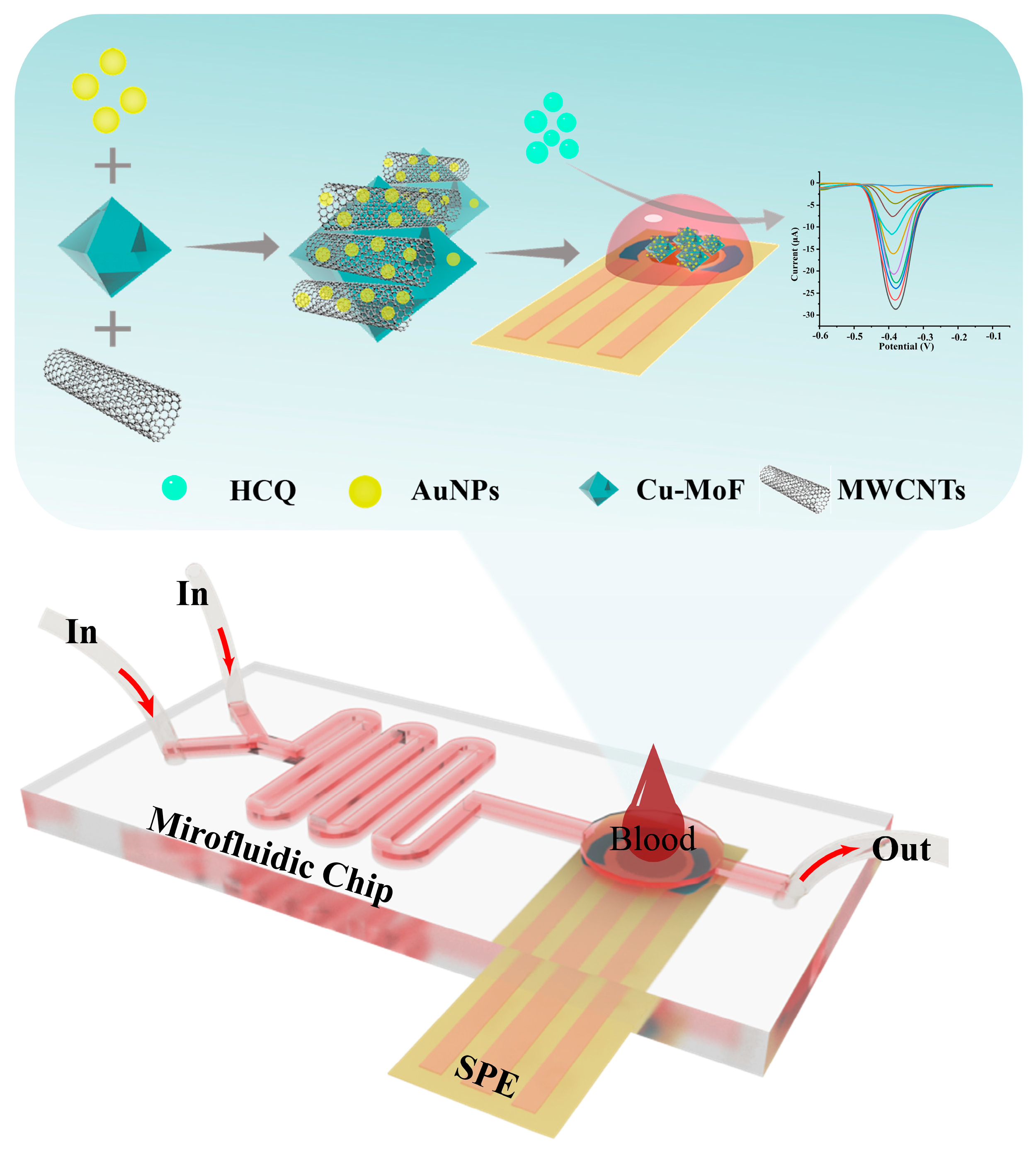
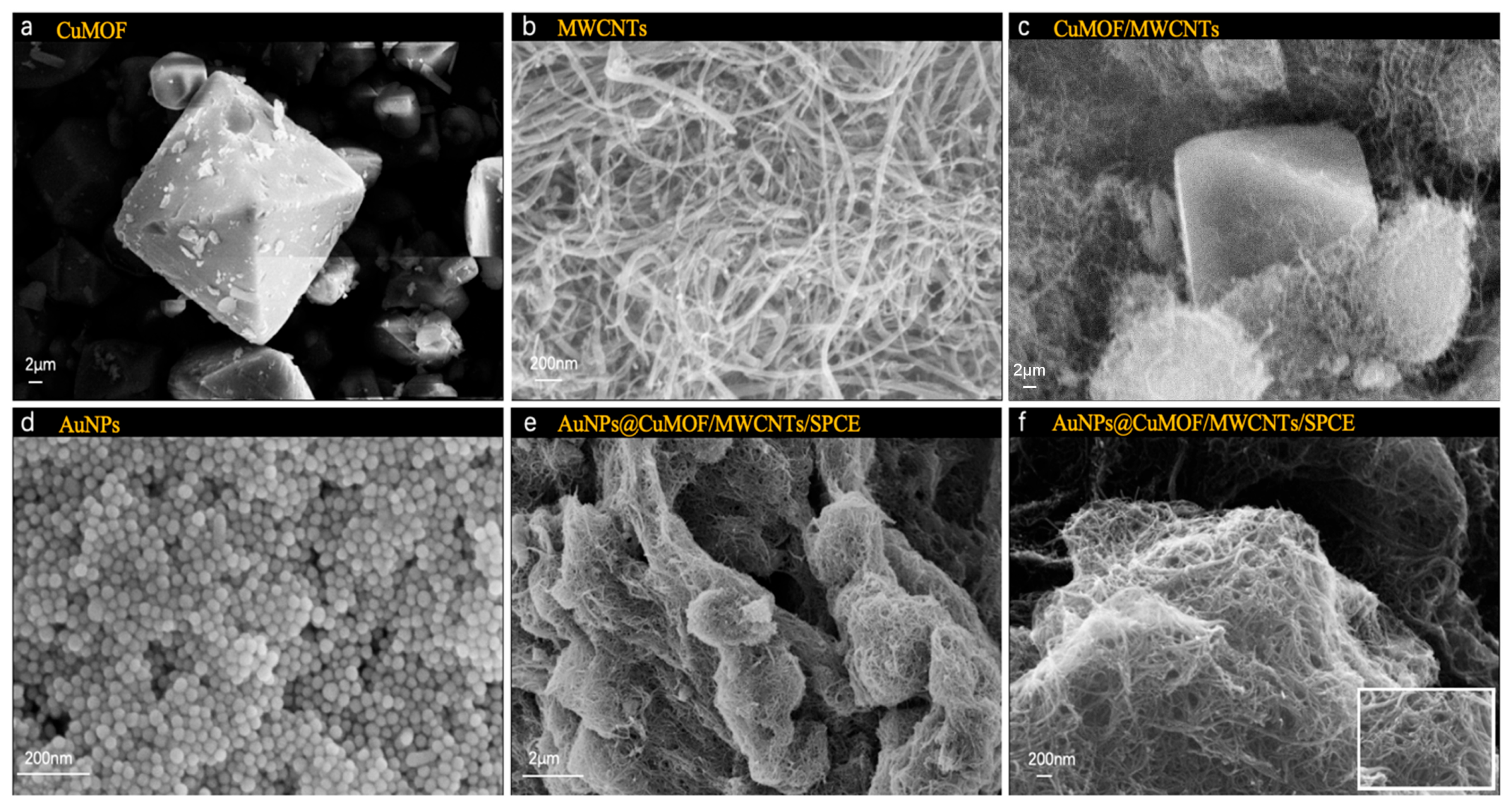
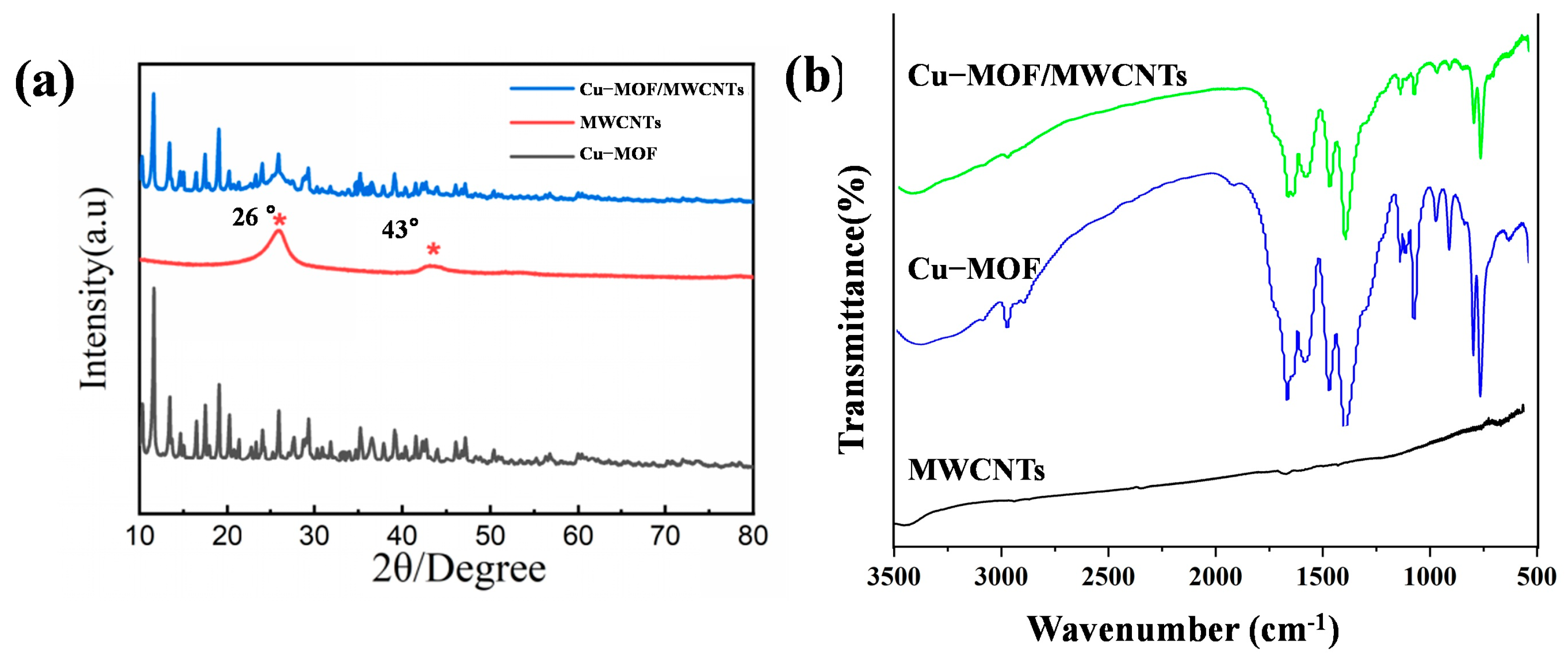
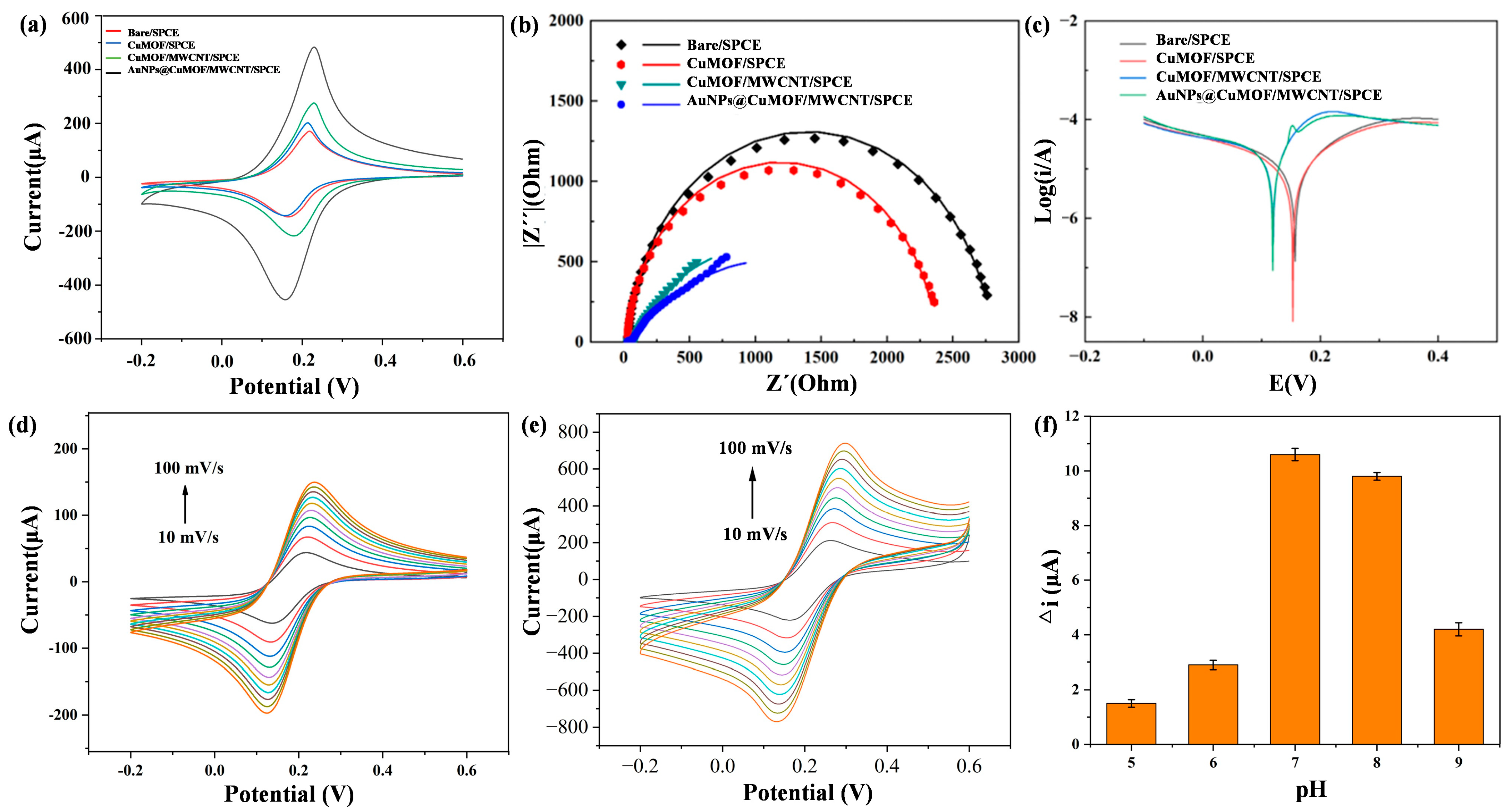
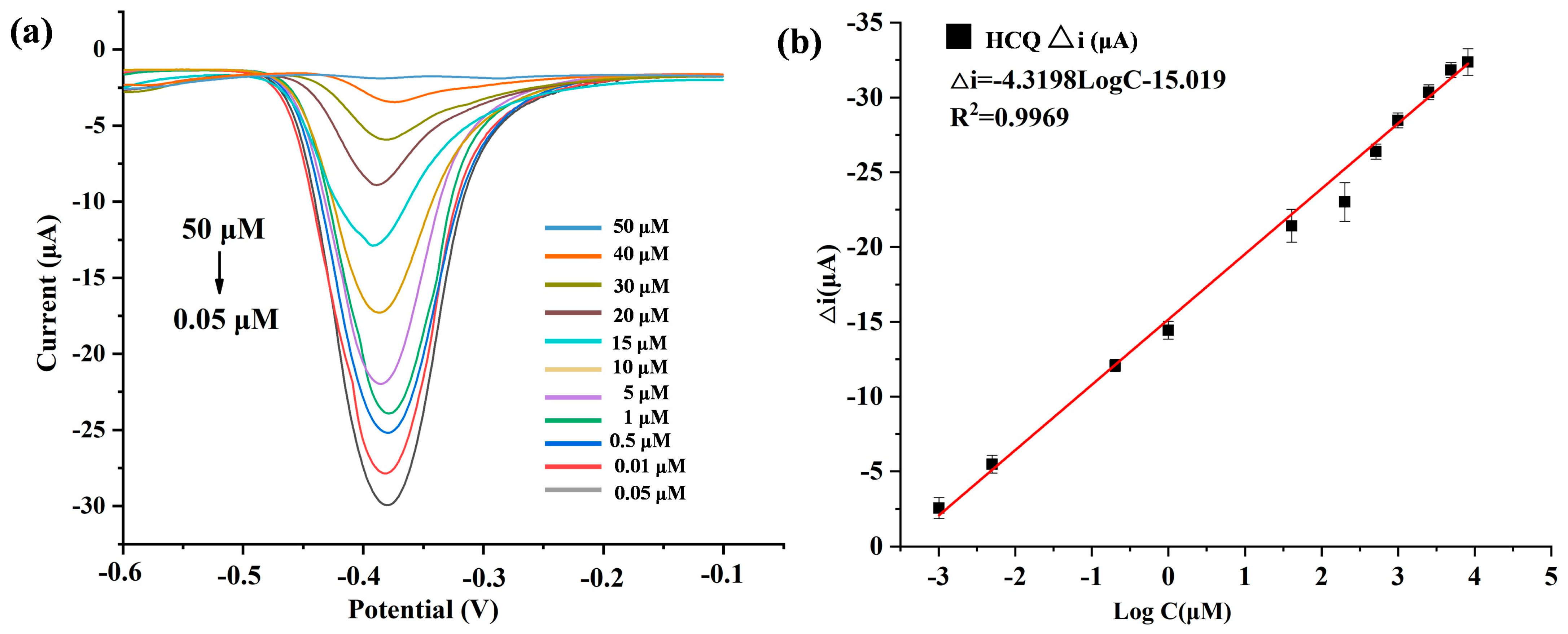

| Sample | Added (μM) | Measured (μM) | RSD (%) | Recovery (%) |
|---|---|---|---|---|
| 1 | 10 | 9.94 | 2.39 | 99.4 |
| 2 | 5 | 5.16 | 6.18 | 103.0 |
| 3 | 1 | 0.95 | 5.21 | 95.0 |
| Method | Sample | Need for Pretreatment | Detection Time | Linear Range | LOD | Ref. |
|---|---|---|---|---|---|---|
| UHPLC-MS/MS | Rat blood | Yes | 4 min | 2.0–5000 ng/mL | 1.0 ng/mL | [29] |
| LC-MS/MS | Human blood | Yes | 9.5 min | 25–2000 ng/mL | 25 ng/mL | [30] |
| LC-ESI-MS/MS | Mouse blood | Yes | 7.5 min | 1–2000 ng/mL | 1 ng/mL | [31] |
| UHPLC-UV | Human serum | Yes | 3 min | 0.25–5 μg/mL | 0.25 μg/mL | [32] |
| AuNPs@Cu-MOF/MWCNTs/GCE sensor | Human serum | No | <5 min | 0.05–50 μM | 19 nM | This work |
Disclaimer/Publisher’s Note: The statements, opinions and data contained in all publications are solely those of the individual author(s) and contributor(s) and not of MDPI and/or the editor(s). MDPI and/or the editor(s) disclaim responsibility for any injury to people or property resulting from any ideas, methods, instructions or products referred to in the content. |
© 2025 by the authors. Licensee MDPI, Basel, Switzerland. This article is an open access article distributed under the terms and conditions of the Creative Commons Attribution (CC BY) license (https://creativecommons.org/licenses/by/4.0/).
Share and Cite
Feng, X.; Zhao, J.; Wu, S.; Kan, Y.; Li, H.; Zhang, W. An Electrochemical Sensor Based on AuNPs@Cu-MOF/MWCNTs Integrated Microfluidic Device for Selective Monitoring of Hydroxychloroquine in Human Serum. Chemosensors 2025, 13, 200. https://doi.org/10.3390/chemosensors13060200
Feng X, Zhao J, Wu S, Kan Y, Li H, Zhang W. An Electrochemical Sensor Based on AuNPs@Cu-MOF/MWCNTs Integrated Microfluidic Device for Selective Monitoring of Hydroxychloroquine in Human Serum. Chemosensors. 2025; 13(6):200. https://doi.org/10.3390/chemosensors13060200
Chicago/Turabian StyleFeng, Xuanlin, Jiaqi Zhao, Shiwei Wu, Ying Kan, Honemei Li, and Weifei Zhang. 2025. "An Electrochemical Sensor Based on AuNPs@Cu-MOF/MWCNTs Integrated Microfluidic Device for Selective Monitoring of Hydroxychloroquine in Human Serum" Chemosensors 13, no. 6: 200. https://doi.org/10.3390/chemosensors13060200
APA StyleFeng, X., Zhao, J., Wu, S., Kan, Y., Li, H., & Zhang, W. (2025). An Electrochemical Sensor Based on AuNPs@Cu-MOF/MWCNTs Integrated Microfluidic Device for Selective Monitoring of Hydroxychloroquine in Human Serum. Chemosensors, 13(6), 200. https://doi.org/10.3390/chemosensors13060200





